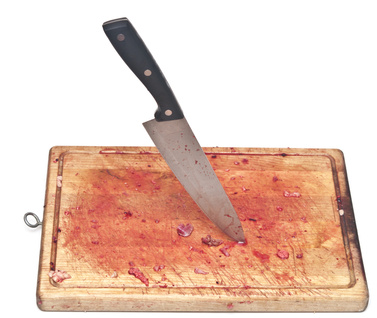



Here’s a quick video from Rachael Ray on how to clean a wood cutting board, and a bit more comprehensive instructions and tips further down this page so don’t forget to scroll down.
Rachael didn’t show this in the video, but it is the most important step because it will rinse off any left over loose items on the board along with washing some of the bacteria on the board surface.
It’s important to note that you should just rinse the board and not fully submerge it into a sink full of water. Doing so may cause your wood cutting board to warp or separate at the seams.
You can clean a wooden cutting board with a number of different products you probably already have around the house. Here’s the top 3.
Clean with Salt
In addition to cleaning, salt will also help remove discolorations aka stains from your wood cutting board so it’s my favorite product to use. It’s also cheap. If you are going to clean your board with salt, you don’t have to worry about drying it after the rinse since you need water anyway. Just use some coarse salt (sea salt or kosher salt for example although I suppose you could use plain margarita salt too) and sprinkle it on the board. Use a sponge or a clean towel to rub it in to the board. Add more salt as needed and keep rubbing to remove the stain. When the stain is gone, rinse the board again and pat dry. Leave standing upright to dry so water won’t sit on the board and cause it to warp.
Clean with Baking Soda
The process for cleaning with baking soda is the same as using coarse salt. I prefer the coarse salt as it has somewhat of an abrasive action to it but if you don’t have coarse salt handy, or just don’t want to use as much of an abrasive baking soda is a little easier on the the board.
Clean with Hydrogen Peroxide
I like to use a paper towel to pat the board dry first after rinsing it because with Hydrogen Peroxide you just leave it sit on the board for a couple minutes. By drying the board more of the peroxide will reach the surface and it won’t be diluted down. The process is simple. You may want to wear gloves to avoid getting the peroxide on your hands. Start by pouring some peroxide on your board. Use something to spread it around – a sponge or paper towel can work. Once you have covered the board, then just let it sit for a bit, say about 2-3 minutes. It will bubble and maybe make some sounds common to peroxide bubbling. Repeat if you feel it’s necessary. Once you’re done, rinse the board, pat dry and leave standing upright to further air dry.
Clean with Vinegar
To clean with vinegar, dilute about 1 tablespoon of vinegar per quart of water, and it’s easiest to do this in a bowl. Depending on the size of your cutting board, just one quart may be enough or you might need more. Mix the water and vinegar so they blend a little, then use a clean white rag or a sponge to spread it on your cutting board. Let it sit for 2-3 minutes to kill the bacteria, and then rinse off. Pat dry and leave standing upright to completely air dry.
Clean with Bleach
I don’t really like this method, but it does work. The instructions are exactly the same as using vinegar, but please use gloves so you don’t damage your skin. I also like to make sure I’m in a well ventilated area since bleach has strong vapors and I don’t like to breathe it. Also be sure to clean your sink and anything else the bleach might get onto (counters for example) well afterwards – you don’t want bleach residue contaminating any food through cross-contamination.
I mentioned this in all the instructions above, but in the event you’re skimming this article (yeah, we all do it!) this is an important step. Rinse off any solution you used to clean your cutting board with when you’re done with that step.
Use a clean cloth or paper towel and pat the cutting board dry so you can remove as much excess water as possible, right after cleaning.
Stand your cutting board up on the edge and let it air dry. This stops the water from soaking into the board and reduces the chance of it warping.
That’s it. It may sound like a lot of work but it’s really easy and can be done quickly once you’ve done it a couple times. Salt is the easiest one in my opinion – its simple, fast and safe.
Occasionally you will want to treat your wood cutting board with oil. This keeps the board from splitting as easily and also the oil on the board will seep in and occupy tiny spaces which in turn keeps the bacteria from doing just that.
You can use mineral oil or coconut oil. I prefer coconut oil myself as it has natural antibacterial and anti-fungal properties and I have it in the kitchen for cooking already. Do not use other natural oils, such as olive oil as they will stink up your board as the oil gets old.
If you've just received a new set of stainless steel cookware (congratulations!), or bought yourself…
The French have a very well known reputation for producing exquisite and incredibly sophisticated foods…
The mighty blender is one of the most versatile items available for the home kitchen.…
With a new year comes the perfect opportunity to pepper our kitchens with new gadgets.…
Sometimes I'm an idiot. Like this time for example, when I left the nice little…
There's something elevated about having your own espresso machine at home. No matter how fancy…